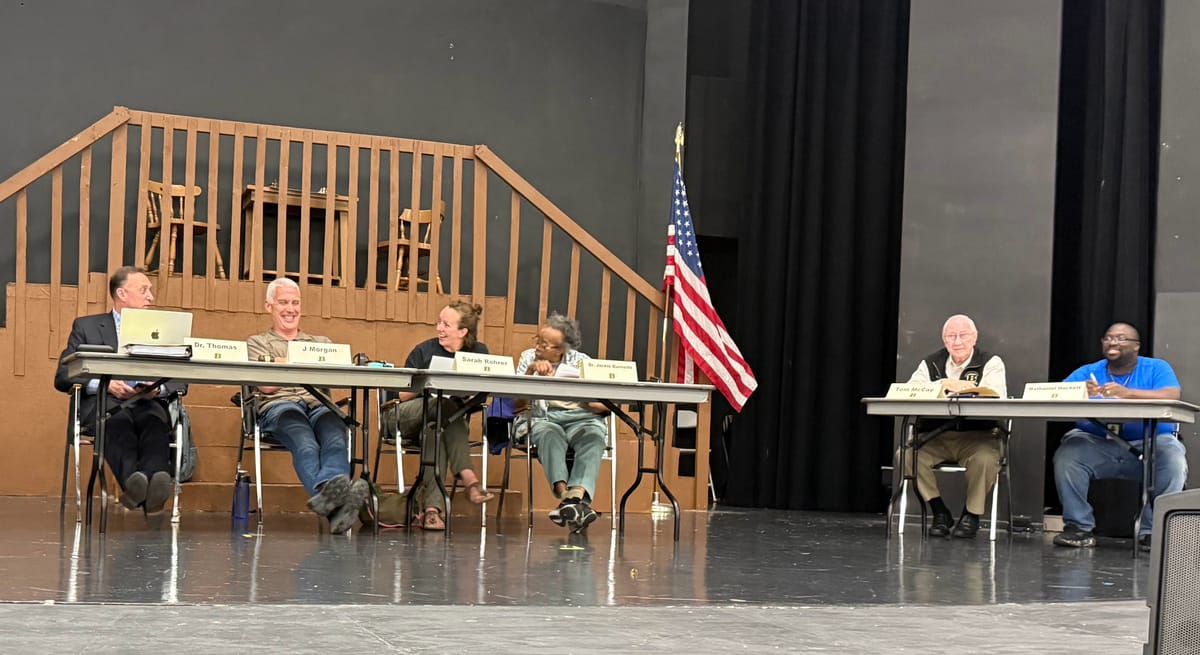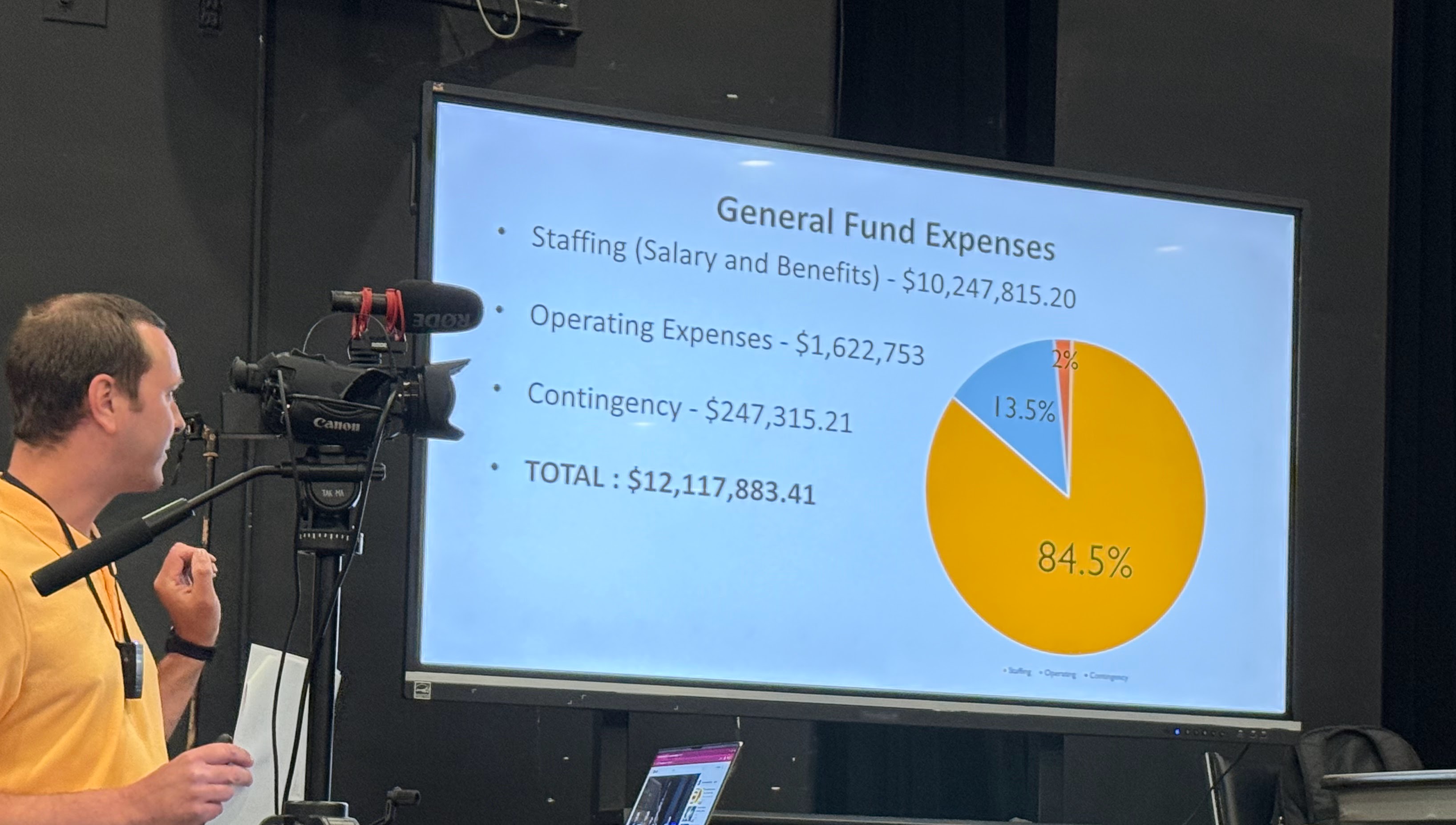Hiring 'competent' superintendent is Board of Ed's job, says interim
Plus, no fraud found, district budget improving, and some positions have been restored

BEREA — A board of education’s top job is to hire a “competent” superintendent, Berea School’s interim superintendent told Board members Monday night.
“That’s the biggest decision you all will make,” interim superintendent, Elmer Thomas, PhD, said during the regular monthly board meeting of the Berea Independent Schools District.
Thomas shared findings from his investigation into the tenure of former District superintendent, Diane Hatchett, PhD. After an audit discovered late last year that the District had a nearly two million dollar deficit which Hatchett struggled to justify to the Board, Chair “J” Morgan placed her on administrative leave on March 31 of this year. As of Tuesday of this week, Hatchett is no longer employed by the District.
Thomas emphasized that while he would not have made some of the decisions Hatchett made, “I haven’t found any fraud by the previous superintendent or anyone in the District,” he told the Board.
“I’ve gone through the [former] superintendent’s spending on travel, on reimbursements, et cetera. While there are many things on there that I disagree with, travel and so forth, they were done legally through our Board’s policies and procedures,” Thomas said. “I would encourage the Board to do more oversight.”
Thomas specified the Board should not only be more proactive about examining the budget in open sessions attended by the public, but also days worked by the superintendent. He told the Board he’d examined the number of days worked by Hatchett throughout her tenure, and discovered that in some years, she was underpaid for the days she worked, but in other years, she was overpaid.
The difference came to about $8,100 that Hatchett owed the District, which when alerted about it, she repaid the amount immediately, Thomas told The Edge in an interview after the meeting.
That Hatchett’s contract listed “reasonable” travel to conferences and other expenses such as memberships in professional associations, and so he did not find such expenses problematic, Thomas told The Edge prior to the Board meeting. He also said it’s difficult to assess what “reasonable” is.
“I’ve looked at so many aspects of the purchasing and spending and our budget, and what I would leave the Board with is, I encourage the Board to be able to have tough conversations and even work sessions about the budget moving forward,” Thomas told the Board.

‘Unusual’ student-teacher ratios
The budget gap was due to insupportable student-teacher ratios, Thomas said.
“To put it in terms of what we heard clearly from the Kentucky Department of Education, one assistant commissioner said that she had never seen a district so small with so many teachers and staff members,” Thomas said. “That’s pretty straightforward.”
Thomas told The Edge that this past year, staffing ratios were, on average, 22 students to 1 teacher, significantly lower than what the state allows — as many as 31 high school students in one class, and up to 24 students per class for kindergarten through fifth grade.
Two factors caused the ratios to become unbalanced, according to Thomas.
First there were teaching positions funded by grants that eventually ended yet the teachers were kept on, as previously reported.
“The general rule of thumb is that when a grant sunsets, the positions with those grants also sunset,” Thomas told the Board. “That has not happened, and it should have happened.”
Without the grant monies to pay these teachers, they were paid instead out of the general fund. Exactly how many such positions were causing the District to overspend is difficult to assess, Thomas explained in an email.
“One of the issues is that during many grants, there would be positions added to the grant that were not fully funded by the grant, therefore the District took on the costs with those positions associated with partial funding from the grant,” Thomas wrote.
The costliest positions were those that were initiated using federal Covid-era funds, according to Thomas.
“There was a lot of coming and going in those positions - custodians, cooks, cleaning contract, etc. that continued to be funded through the general [fund] after ESSER [federal Covid funds] closed,” Thomas wrote in the email.
The pain of ‘94 percent’
The total income for the District this school year is 12 million dollars, according to Thomas. Meanwhile, the total cost of salaries this school year is 11.3 million dollars.
“That comes to 94 percent of your total budget being spent on salaries,” Thomas said. “It is impossible to run a district with only six percent left for everything else.”
For the 2025-2026 school year, the District’s budget reflects that salaries will comprise about 84 percent of the total budget, Thomas said. In the 2026-2027 school year that number should be 82 percent, he said.
Then there was a significant drop in enrollment.
“We had a number of students leave during and right after Covid, and we’ve not recovered from that,” Thomas told the Board. “If you go back to 2023, Berea is down about 115 students, most of them in the high school.”
Since the majority of the District’s funding is from the state, and is calculated according to the number of students enrolled and the average attendance rate, the loss of that many students is significant. “Generally speaking, 115 less students is almost a half a million dollars less in funding each year,” Thomas said.
The staffing levels, however, were not adjusted to this new reality, according to Thomas.
“Clearly, those are the two issues: staffing at 94% of your income … and losing students,” Thomas said.

Some ‘good news’
Thomas focused on the future and shared his optimism that if the Board is vigilant, such as checking the budget during the school year to ensure it’s on track, that the District would be fine.
“We’re starting to see some really positive dominoes fall into place,” he said, such as the District having been told it will receive its full Title I federal funding for the elementary and middle schools in the upcoming school year.
“That will enable us to bring two more teachers back, one at each school,” Thomas said. “So, just really tremendous news right there.”
Also positive, he said is that the state JAG (Jobs for America’s Graduates) program will completely fund JAG in the District this year. Thomas thanked Morgan for having arranged the meeting with the state’s JAG that led to the funding.
A part-time physical education teacher has also been added back into the budget, Thomas said.
Thomas is looking into shoring up the engineering pathway program and expects that soon there will be good news on that front, he said in an interview after the meeting.
Budget lean but clean
Thomas said he worked with the District’s finance director, Nathan Sweet to create a balanced budget for the school year ahead, and that he expected the District would be in the black by June of 2026. The Board unanimously approved the tentative budget later in the meeting.
Sweet told the Board that the District has been regularly overspending by about $270,000 monthly. Moving forward, there will be tighter projections for what income the District can count on, and a special focus on improving enrollment in order to increase the per pupil funding from the state. Currently, the District receives about 60% of its general funding directly from the state baed on enrollment and average attendance rates.
Last year’s enrollment forecast would have brought in an additional $343,000 from the state but the District missed the target by that much. “I think we were overly optimistic,” Sweet said.
Enrollment director Kyle French also told the Board that he was being “more pessimistic” with his enrollment projections this year.
“Enrollment is my big worry,” French told the Board.
French said that before Covid, the District averaged over one thousand students annually. Currently, that number is 913. For this coming school year’s enrollment, French said he is projecting 850 students.
That the District is now moving forward from its budget woes made French optimistic there will be an uptick in enrollment, he said. “Hopefully, we’ll be pleasantly surprised.”
Average attendance rates have been at 92 percent, he said.
Sweet said that the current budget has a 2 percent contingency fund, but that he would in time like it to become higher.
“I think ten percent is probably pretty high,” Sweet told the Board. “I think it’s my job to push it for the higher end, and you all pull it to the low end, and we meet in the middle.”
Volunteering time
Thomas told The Edge he will continue to work with the District on a volunteer basis after incoming superintendent Ryan Neaves, PhD, assumes the role on July 1.
“I want to see Berea succeed,” he said.
After public demand for more transparency, the meeting was the first one live streamed and recorded. You can watch it here. The next board of education meeting will be on Monday, June 16, at 7PM in the Kennedy Theater at Community School.
Become a paid subscriber to The Edge and never miss a moment of in-depth coverage of your hometown news.
